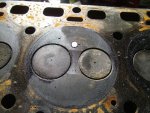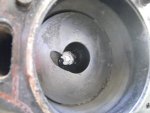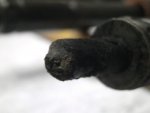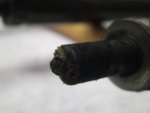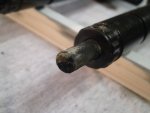oddshot
Active member
- 781
- 121
- 43
- Location
- Jasper, Georgia
For what its worth.
Recently, I have been disassembling a LDT 465 to determine the cause of its broken cam shaft. Interestingly, this engine has been run for one year on a WMO blend. I have determined that this camshaft failed due to worn cam bearing and that its fuel did not enter into the failure at all. For more information about this camshaft failure please go to: http://www.steelsoldiers.com/showthread.php?130913-LDT-465-Multifuel-Andy3-s-Broken-Camshaft
Since I had it apart, I took pictures of the combustion chambers and the injectors. I also tested the break pressures and spray patterns of the injectors, both before and after rebuilding them. I thought that those using WMO might be interested in them.
Andy3's engine was built by White in 2-84. Andy3's M35A2 is a 1971 and has about 54,000 miles on it at the time of the failure, obviously this is a replacement engine but there is no way to determine the number of hours on it. There are NO rebuild tags on it, and, so far, I do not see any signs of anyone having been inside this engine. The inside of this engine is VERY clean, it appears to have had frequent oil changes and so far I find no sign of abuse, harsh treatment or evidence of overheating. Andy reports that the engine had been running well at the time of the failure.
Andy has told me, "I had the motor for almost a year. The highest I have run is up to 25% D2 with the balance being WMO and gas at a 80/20 blend filtered to 3 microns. The owner before me used to change the oil and pour it directly into the tank.". Andy also reports that the engine had been running well and strong until the cam failed. Andy will answer any other questions posted about his engine.
Therefore, these pictures show components from an engine with an indicated 54,000 miles that has been run for one year on a WMO blend, also having a history of SOME previous WMO fuel use. The swirl chambers on the pistons are black with use, but have no crusty build up. The cylinder heads DO show some crusty build up, but, based on my experience, I find the amount to be consistent with an engine having been operated 54,000 miles. There IS some build up in the holes the injectors feed into but not to the point that the delivery of fuel was impaired and much less than I expected to see.
Recently, I have been disassembling a LDT 465 to determine the cause of its broken cam shaft. Interestingly, this engine has been run for one year on a WMO blend. I have determined that this camshaft failed due to worn cam bearing and that its fuel did not enter into the failure at all. For more information about this camshaft failure please go to: http://www.steelsoldiers.com/showthread.php?130913-LDT-465-Multifuel-Andy3-s-Broken-Camshaft
Since I had it apart, I took pictures of the combustion chambers and the injectors. I also tested the break pressures and spray patterns of the injectors, both before and after rebuilding them. I thought that those using WMO might be interested in them.
Andy3's engine was built by White in 2-84. Andy3's M35A2 is a 1971 and has about 54,000 miles on it at the time of the failure, obviously this is a replacement engine but there is no way to determine the number of hours on it. There are NO rebuild tags on it, and, so far, I do not see any signs of anyone having been inside this engine. The inside of this engine is VERY clean, it appears to have had frequent oil changes and so far I find no sign of abuse, harsh treatment or evidence of overheating. Andy reports that the engine had been running well at the time of the failure.
Andy has told me, "I had the motor for almost a year. The highest I have run is up to 25% D2 with the balance being WMO and gas at a 80/20 blend filtered to 3 microns. The owner before me used to change the oil and pour it directly into the tank.". Andy also reports that the engine had been running well and strong until the cam failed. Andy will answer any other questions posted about his engine.
Therefore, these pictures show components from an engine with an indicated 54,000 miles that has been run for one year on a WMO blend, also having a history of SOME previous WMO fuel use. The swirl chambers on the pistons are black with use, but have no crusty build up. The cylinder heads DO show some crusty build up, but, based on my experience, I find the amount to be consistent with an engine having been operated 54,000 miles. There IS some build up in the holes the injectors feed into but not to the point that the delivery of fuel was impaired and much less than I expected to see.
Attachments
-
85.2 KB Views: 273
-
96.4 KB Views: 267
-
91 KB Views: 264
-
90.7 KB Views: 289
-
29.3 KB Views: 272
-
34.7 KB Views: 263
-
25.8 KB Views: 256
-
29.1 KB Views: 251
-
43.4 KB Views: 256
-
43.7 KB Views: 275
Last edited:





